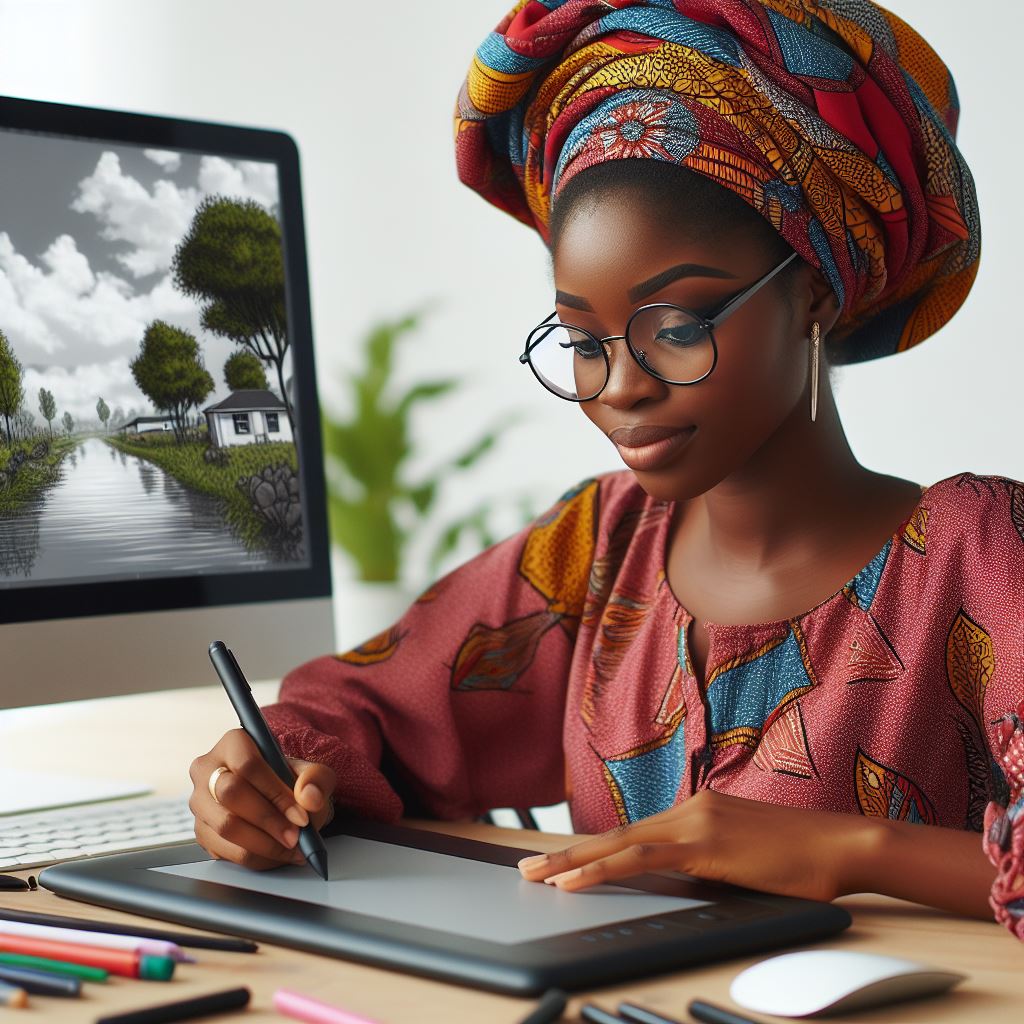Introduction
Nigerian art students have a multitude of grants and scholarships tailored to their educational needs.
These financial aids play a pivotal role in supporting their pursuit of artistic excellence.
Given the often exorbitant costs associated with art education, such assistance alleviates the burden on students and enables them to focus on honing their craft.
Despite the availability of these resources, numerous challenges persist within the Nigerian art student community.
Limited awareness about available funding opportunities, coupled with the competitive nature of grant applications, poses hurdles for aspiring artists.
Additionally, socioeconomic factors and institutional barriers further compound the difficulties faced by many students.
In light of these challenges, it becomes imperative to explore and advocate for increased access to financial aid for Nigerian art students.
By addressing these barriers and promoting equitable distribution of resources, we can ensure that every aspiring artist has the opportunity to pursue their passion and contribute to the vibrant cultural landscape of Nigeria.
Available grants and scholarships for Nigerian art students
Organizations, Foundations, and Government Agencies Providing Financial Assistance
In Nigeria, numerous entities recognize the importance of supporting budding artists through financial aid.
Among these are prominent organizations like the Society of Nigerian Artists (SNA), the National Association of Nigerian Students (NANS), and governmental bodies such as the Federal Ministry of Education.
Additionally, private foundations like the Tony Elumelu Foundation contribute to the cause by offering scholarships and grants specifically tailored to support the artistic endeavors of Nigerian students.
Providing Information on Eligibility Criteria and Application Processes
Each grant or scholarship program has its own unique set of eligibility criteria and application procedures.
For instance, eligibility for the SNA grant typically requires enrollment in an accredited art program and demonstration of financial need.
Applicants must submit a portfolio of work and a personal statement outlining their artistic aspirations.
Similarly, NANS scholarships often require Nigerian citizenship, enrollment in a recognized institution, and academic merit.
Prospective recipients are typically asked to submit an essay detailing their academic achievements, artistic pursuits, and financial circumstances.
Government scholarship schemes administered by the Federal Ministry of Education may have varying eligibility criteria, such as academic excellence, financial need, and citizenship.
Application processes usually involve submitting an online form along with supporting documents like academic transcripts.
Details on the Amount of Funding Available and Specific Requirements
The funding amounts and specific requirements for each grant or scholarship vary depending on the sponsoring organization or agency.
For instance, the SNA grant may offer funding of up to ?100,000 per recipient, which can be used for tuition fees, art supplies, or other educational expenses.
NANS scholarships typically range from ?50,000 to ?200,000 per student, depending on available funding and the number of applicants.
The Federal Government Scholarship Scheme may provide partial tuition waivers or full scholarships based on academic performance and financial need.
Private foundations like the Tony Elumelu Foundation offer scholarships with varying funding amounts and requirements.
Recipients may receive financial support for tuition fees, mentorship opportunities, and access to networking events.
They are often required to develop a business plan or artistic project that aligns with the foundation’s goals of fostering entrepreneurship and social impact.
Understanding these funding opportunities and their respective requirements is essential for Nigerian art students seeking financial assistance to pursue their educational and artistic goals.
By leveraging available resources and preparing strong applications, aspiring artists can access the support they need to thrive in their creative endeavors.
Read: Internship Opportunities for Communication Arts Students
Tips for finding and applying for grants and scholarships
Strategies for Researching and Identifying Potential Funding Opportunities
Researching and identifying potential funding opportunities is a critical step for Nigerian art students seeking financial assistance.
Several strategies can help students uncover available grants and scholarships tailored to their needs and aspirations.
Firstly, students can explore websites of organizations, foundations, and government agencies known for supporting artistic endeavors.
These platforms often provide detailed information about their scholarship and grant programs, including eligibility criteria, application deadlines, and funding amounts.
Additionally, students can leverage online databases and scholarship search engines to streamline their search process.
Websites like ScholarshipPortal, Scholarships.com, and Fastweb allow users to filter scholarships based on various criteria such as field of study, academic achievement, and nationality.
Networking with fellow artists, mentors, and faculty members can also yield valuable insights into potential funding opportunities.
Attending art exhibitions, workshops, and conferences provides opportunities to connect with professionals in the field who may be aware of relevant scholarships or grants.
Offering Advice on How to Prepare a Strong Application
Preparing a strong application is crucial for securing financial assistance.
To stand out among other applicants, students should focus on crafting a compelling personal statement that showcases their passion for art, academic achievements, and future aspirations.
In their personal statement, students should highlight their unique artistic style, experiences, and accomplishments.
They should articulate how receiving the scholarship or grant would contribute to their academic and artistic growth, as well as their long-term career goals.
Gathering supporting documents, such as academic transcripts, letters of recommendation, and a portfolio of artwork, is equally important.
Students should ensure that these documents accurately reflect their talents, achievements, and potential for success in the field of art.
Providing Resources for Students to Seek Guidance and Support
Navigating the application process can be daunting, but students can seek guidance and support from various resources available to them.
Many educational institutions have dedicated offices or advisors specializing in scholarship and grant opportunities.
Students can also benefit from workshops, webinars, and informational sessions hosted by organizations and foundations offering financial assistance.
These events provide valuable insights into the application process and tips for crafting a competitive application.
Online forums and social media groups dedicated to art education and scholarship opportunities can also be valuable sources of support and information.
Engaging with peers and professionals in these communities allows students to exchange advice, share experiences, and stay informed about upcoming opportunities.
By utilizing these strategies and resources, Nigerian art students can enhance their chances of securing the financial assistance they need to pursue their educational and artistic aspirations.
With careful research, thoughtful preparation, and support from their communities, students can embark on their artistic journey with confidence and determination.
Read: Comparing Communication Arts and Mass Communication
Benefits of receiving grants and scholarships for art students
The Impact of Financial Aid on Access to Education and Career Opportunities
Financial aid plays a pivotal role in facilitating access to education and career opportunities within the art industry, particularly for Nigerian students facing financial constraints.
By providing scholarships and grants, organizations and foundations empower aspiring artists to pursue their academic and artistic goals without the burden of financial worries.
Ways in Which Funding Can Alleviate Financial Burdens
Financial aid alleviates the financial burdens associated with art education, allowing students to focus on their creative pursuits wholeheartedly.
With funding support, students can afford tuition fees, art supplies, and other essential expenses, enabling them to fully engage in their studies and artistic endeavors.
Moreover, financial aid opens doors to opportunities that may have otherwise been out of reach for students from economically disadvantaged backgrounds.
By removing financial barriers, scholarships and grants create a more equitable playing field, enabling talented individuals to pursue their passion for art regardless of their socioeconomic status.
Success Stories of Nigerian Art Students
Countless Nigerian art students have benefited from grants and scholarships, propelling them towards success in their artistic careers.
These success stories exemplify the transformative impact of financial aid on individual lives and the broader art community.
For instance, Ayodele Adeoye, a talented painter from Lagos, received a scholarship from the Society of Nigerian Artists (SNA) during his undergraduate studies.
With the financial support provided by the scholarship, Ayodele was able to focus on refining his craft and participating in prestigious art exhibitions both locally and internationally.
Today, he is recognized as one of Nigeria’s emerging artists, with his works fetching high prices in the art market.
Similarly, Ngozi Okonkwo, a sculptor based in Abuja, received a grant from the National Association of Nigerian Students (NANS) to pursue her graduate studies in fine arts.
The financial assistance enabled Ngozi to attend workshops, purchase specialized equipment, and travel for research purposes, ultimately enhancing her artistic skills and expanding her professional network.
Today, she is celebrated for her innovative sculptures and has exhibited her work in galleries across Nigeria and beyond.
These success stories underscore the transformative power of financial aid in shaping the trajectory of Nigerian art students’ careers.
By investing in the next generation of artists through scholarships and grants, organizations and foundations contribute to the vibrancy and diversity of the Nigerian art scene, fostering a culture of creativity, innovation, and excellence.
Read: Developing Critical Thinking in Language Arts

See Related Content: Exploring Nigeria’s Rich Art History and Heritage
See Related Content: How Criminology Helps Fight Crime in Nigeria
Challenges Faced by Nigerian Art Students in Accessing Financial Aid
Addressing Systemic Barriers
Systemic barriers such as lack of awareness, limited funding opportunities, and bureaucratic hurdles pose significant challenges for Nigerian art students seeking financial aid.
These barriers can prevent deserving individuals from accessing the resources they need to pursue their artistic aspirations.
Identifying Socio-Economic Factors
Marginalized groups within the art community, including individuals from low-income backgrounds and underrepresented communities, are disproportionately affected by socio-economic factors.
Economic inequality, lack of access to quality education, and systemic discrimination further exacerbate their challenges in accessing scholarship programs and other forms of financial assistance.
Proposing Potential Solutions
To support greater inclusivity and equity in scholarship programs, several initiatives and solutions can be implemented
Increased Outreach and Awareness
Organizations and foundations should improve outreach efforts.
They collaborate with educational institutions, community organizations, and art associations.
This ensures information about available opportunities reaches all segments of the art community.
Outreach involves disseminating information and raising awareness about scholarship programs.
Diversification of Funding Sources
Stakeholders address limited funding opportunities by diversifying funding sources.
They partner with private donors, corporations, and philanthropic organizations.
This expands the pool of available resources and creates more opportunities for financial assistance.
Streamlined Application Processes
Bureaucratic hurdles can deter potential applicants from pursuing scholarship opportunities.
Simplifying applications, reducing administrative burdens, and providing support can remove barriers and encourage more participation in scholarship programs.
Targeted Support for Marginalized Groups
Scholarship programs recognize challenges faced by marginalized groups.
They implement targeted support initiatives to address specific needs.
This includes mentorship programs, financial literacy workshops, and networking opportunities.
These empower marginalized students and enhance their chances of success.
Advocacy for Policy Changes
Advocacy efforts aimed at addressing systemic barriers and promoting greater inclusivity in scholarship programs are essential.
This may involve advocating for policy changes at institutional and governmental levels to address inequalities and create an equitable environment for artists.
By implementing these solutions, stakeholders can create a more inclusive and equitable landscape for scholarship programs in Nigerian art.
By addressing systemic barriers together, we can ensure every aspiring artist has the chance to pursue their passions.
Read: Student Experiences: Life in Communication Arts
Explore Further: How to Prepare for Foreign Language Proficiency Tests
Explore Further: How Foreign Languages Enhance Nigerian Education
Success stories and testimonials from Nigerian art students
Featuring Personal Accounts of Scholarship Recipients
Personal accounts of students who have received grants or scholarships provide invaluable insights into the transformative impact of financial assistance on their educational journeys.
These narratives highlight the challenges they faced and the opportunities they seized with the support of scholarships.
Showcasing Examples of Overcoming Obstacles
Financial assistance has enabled countless individuals to overcome obstacles and pursue their artistic goals.
For instance, Sarah Ahmed, a talented painter from Kano, faced financial constraints that threatened to derail her dreams of attending art school.
Receiving a scholarship from the Society of Nigerian Artists (SNA) enabled her to enroll in a fine arts program and pursue painting.
Similarly, David Okafor, a sculptor from Enugu, encountered difficulties in accessing quality art education due to limited financial resources.
With a scholarship from the National Association of Nigerian Students (NANS), David attended a prestigious art institute and honed his sculpting skills.
Today, he is recognized for his innovative sculptures and exhibits his work in galleries across the country.
Including Testimonials from Industry Professionals
Testimonials from mentors, educators, and industry professionals further underscore the impact of funding on student success.
Dr. Aisha Bello, a renowned art historian and educator, attests to the transformative power of scholarships in empowering aspiring artists to pursue their creative aspirations.
She notes, “Financial assistance not only provides students with access to education but also instills confidence and enables them to fully realize their artistic potential.
Similarly, prominent art curator Tunde Adeyemi emphasizes the importance of scholarships in nurturing talent and fostering community diversity.
Scholarships provide aspiring artists with the support they need to thrive,” he says.
By investing in the next generation of creatives, we ensure a vibrant and inclusive art scene for years to come.
Personal accounts and testimonials compellingly show the profound impact of financial assistance on student success in Nigeria’s art community.
Scholarships and grants empower individuals to overcome obstacles, pursue artistic passions, and enrich society’s cultural fabric.
Discover More: Impact of Nigerian Arts on African Cinema
Find Out More: Challenges Facing Nigerian Languages in Modern Times
Discover More: Photography: Top Nigerian Photographers
Transform Your Career with Expert Guidance
Get personalized mentorship consulting that’s tailored to your unique path. Our expert advice is actionable and exclusive.
Get StartedConclusion
As we conclude, it is important to recap the key points discussed in this blog post.
Grants and scholarships play a crucial role in providing financial support to Nigerian art students, enabling them to pursue their passions and dreams.
Furthermore, these opportunities are essential in nurturing talent and fostering diversity in the Nigerian art community.
By providing access to education and resources, grants and scholarships help in creating a more inclusive and vibrant space for artists to thrive.
We encourage our readers to explore the available opportunities for grants and scholarships in the Nigerian art scene.
Supporting initiatives that promote access to arts education is not only beneficial to individual artists but also to the overall cultural landscape of Nigeria.
By investing in the next generation of Nigerian artists through grants and scholarships, we can help cultivate a vibrant and diverse art community that reflects the richness of our culture and heritage.




